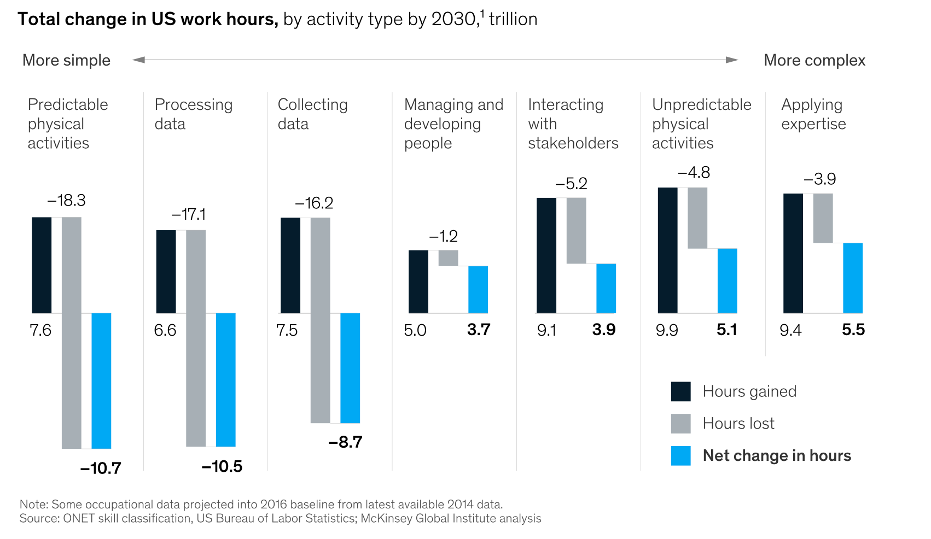Automation in retail – more of a MUST than a CHOICE
Before the global pandemic crisis, the McKinsey Global Institute made a prediction in 2019 that automation would transform retail business models and the wider value chain .
According to their research, current technology could automate nearly half of the activities in the retail industry.
Although efficiency is commonly viewed as the primary incentive for adopting automation technologies, retailers see innovation as crucial for their survival.
Retail automation as a job creator
Initially, it was predicted that automation in the retail industry would result in a 5% reduction in jobs. However, this turned out to be inaccurate due to the opposing effect of the scarcity of human resources in the industry, which is a common challenge across many other industries as well. Additionally, automation leads to the creation of jobs and the need for reskilling as companies invest in growth.
Therefore, contrary to popular belief, automation is not a threat to jobs in retail. Rather, the lack of available human resources has impeded the integration of automation strategies and technologies in the industry. Margin pressure has made automation a requirement rather than a choice.

The application of in-store automation technologies can result in a savings of more than 50% of working hours. This can be achieved through the implementation of various components such as electronic shelf-edge labels, self-checkout terminals, shelf-scanning robots, and partially automated backroom unloading.
These technologies have been successfully deployed on a large scale and offer internal rates of return that surpass historical retail hurdle rates.
However, in some cases, the lack of skills, capabilities, and adequate funding impedes the adoption of these changes. Retailers often tend to invest in small steps and replicate last year's capital spending due to various bottlenecks.
24/7 self service retail – more than vending
Investing in 24/7 self-service retail technology can lead to even greater savings and faster returns on investment (ROI). These sales channels, which are similar to those found in the vending machine industry, generate sales with minimal personnel involvement and lower costs. Retail robots operating these 24/7 shops typically offer a reduced product selection, require minimal shop floor space, and can be located in remote areas close to consumers.

According to the authors of this study, retailers who do not implement automation will fall behind. Amazon's Amazon Go retail concept has been the most significant disruptor, with reduced wait times and personalized promotions based on customer insights. Other retailers, such as Ahold Delhaize and Albertsons, are using automated mini-warehouses for in-store digital order fulfillment.
Some retailers are exploring technology use cases for employee activities, such as Target and Walmart's investments in autonomous cleaning robots and Walmart's use of virtual-reality headsets for associate training and FAST Unloader technology to automate store backrooms.
New operating model
The addition of technology can create various operating models for stores, distribution centers, and headquarters.
Automation can lead to the creation of more and smaller outlets or reduce team sizes, enabling each employee to take on a broader range of responsibilities.

Real-time data and analytics can facilitate faster decision-making processes.
For instance, a store that incorporates self-scanning cashiers and 24/7 self-service robots can automate a significant portion of traditional store activities, freeing up additional resources for in-store customer service and online order fulfillment.
Skills needed to implement retail automation
Skilled employees, rather than real estate costs, are the driving force behind decisions in the retail industry. To quickly fill specific skill gaps in a retail automation strategy, acquiring talent and providing flexible working models, such as part-time or freelance work, are crucial. While hiring new employees may seem like an effective solution, reskilling current employees can bridge the skill gap more quickly and at a lower cost. On average, reskilling an employee costs less than 10% of their annual salary, while replacing an employee can cost 20 to 30% of their annual salary.
Retail automation will result in better-paying jobs, with higher skill requirements and lower turnover rates.
The retail industry has entered the future of work, and companies that delay their response face a higher risk of falling behind.
Addressing automation and workforce transitions should be a top priority for every retail management team.
Subscribe here to get the latest news from the automation and retail industry. We will also keep you updated on our new product launches and attending events.

 Uniqlo
Uniqlo